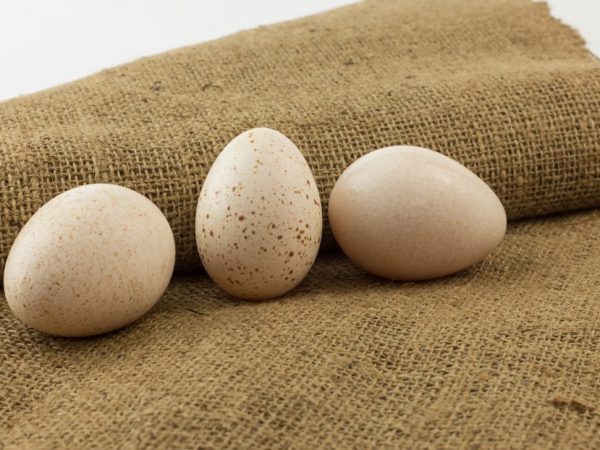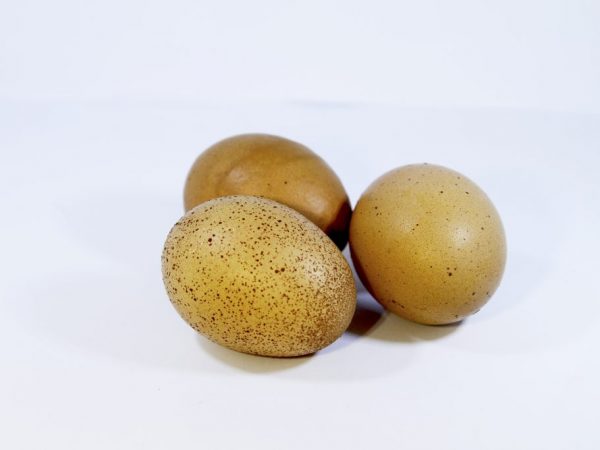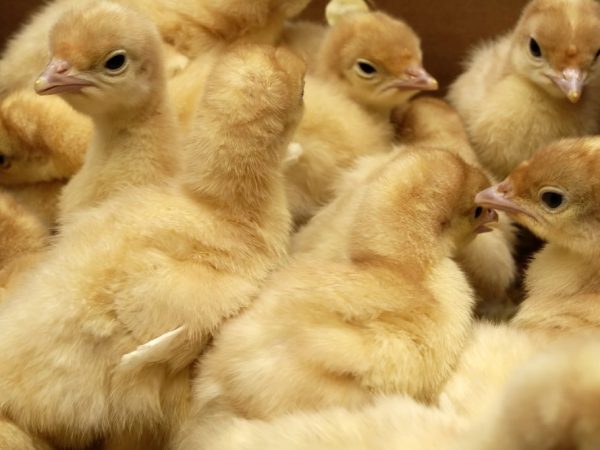Features of incubation of turkey eggs
Turkey eggs have a high hatchability rate. Therefore, instead of buying turkey poults every year, it is advisable to purchase an incubator once and hatch chicks from the eggs yourself. Consider how turkey eggs are incubated, what temperature and humidity should be in the incubator, and how often hatching eggs should be turned over.

Features of incubation of turkey eggs
Incubator selection
Before we consider how the incubation of turkey eggs occurs at home, we will say a few words about the equipment you cannot do without. To remove turkey poults, you will need to acquire incubator.
There are many models on sale today. First of all, we determine the size of the incubator. If you are not going to breed birds on an industrial scale, then it is enough to get by with medium-sized equipment. If you plan to sell chicks, then purchase incubators with a capacity of 70-100 eggs.
Pay attention to the functionality of the incubator. It is desirable that it be equipped with an egg-turning function. With such equipment, the process will not take much time. If it is not possible to purchase an automatic incubator, which is quite expensive, then opt for semi-automatic models. Their price is much lower, but the turnover of the entire masonry is carried out by pressing the lever.
We will not dwell on this issue any longer. If you have any questions, you can consult the specialists in the store. Let's just make a reservation that blitz 72 incubators are especially popular.
Selection and preparation of eggs
To a large extent, the hatchability percentage depends on the quality of the hatching egg. First of all, it must be fresh. Therefore, you need to collect eggs just before laying in the incubator (7-10 days). Since the incubation conditions will be the same, it is advisable to select eggs of the same size. Immediately discard specimens that have damage or defects (cracks, chips). Also toss the irregularly shaped eggs aside.
Features of storage of hatching eggs
Whether or not the incubation of turkeys is successful depends largely on the correct storage of the eggs. It should be understood that the longer the shelf life of the material, the less likely it is to hatch chicks. So, on the 5th day, the probability that a viable chick will be born is 84.5%, and by the tenth day this probability drops to 73.3%. After 25 days, this probability is 0.
We store the hatching eggs before laying in special trays, where they can be placed vertically. We put the eggs in such a way that their blunt edge is on top. After 4 days of storage, turn the eggs over to the other side. If you initially lay eggs in a discord, then it is easy to get confused which ones are upside down and which ones are not.And if you do not carry out a revolution, then the embryo may not form correctly. As a result, even if a chick appears, it will turn out to be unviable.
To make the incubation egg viable, we store it at a temperature of 12-140C. You also need to ensure the room humidity is 80%.
Disinfection and cleaning of eggs
Before being placed in the incubator, the eggs are not washed, but only cleaned of dirt. Before placing them in the incubator, remove all debris, if any, and disinfect. For this, it is advisable to use potassium permanganate, glutex or hydrogen peroxide. We disinfect the eggs after they have warmed up to room temperature.
During disinfection at home, you should not bathe the material prepared for the bookmark in a bath of potassium permanganate or other antiseptic. It is enough to treat it with a napkin soaked in an antiseptic. You should also not wipe the turkey eggs. Let them dry naturally.
Both large and small eggs often do not produce viable chicks. Therefore, we opt for medium-sized specimens.
Ovoscopy

Eggs should be tested for suitability
You can check whether a turkey hatching egg is fertilized using special equipment called ovoscope... When scanning an incubation egg, you need to pay attention to the presence of a variety of clots inside, which indicate that these specimens are unsuitable for incubating turkey poults.
Ideal specimens for incubation are those eggs that have:
- the yolk, which has no clear boundaries, is located in the center;
- the air chamber is located at the blunt end;
- the protein has no inclusions and is transparent;
- The yolk moves very slowly when turned over.
If at ovoscopy microcracks are found on the egg shell, then it should be discarded.
Incubator bookmark
The correct laying of turkey eggs is a guarantee of a successful outcome. Before laying, we warm up the selected specimens to room temperature. Only after that we load the masonry into the device. Loading can be performed vertically or horizontally (it all depends on the design features of the device). When loading vertically, it is very important that the masonry is in the correct position. Place the eggs in such a way that the sharp end is at the bottom, at an angle of 450 to the trays.
Many people start having problems already when they need to make the first turn of the masonry. To avoid complications, mark one side of the eggs with a marker. It remains only to remember whether the marked or unmarked side should be visible during the next turn. But this problem occurs only with horizontal loading. When working with a device equipped with an auto-rotate function, you don't have to rack your brains at all.
We make the turn at a specific time. We turn over the masonry for the first time after 12 hours. Then, the interval between coups varies from 3-4 to 6 hours. We turn over the masonry at the same time. You cannot make a coup during the day every 2 hours, so as not to carry out the procedure at night. This will negatively affect the hatchability rate.
periodically spray the masonry. This will help not only maintain the desired level of humidity inside the incubator, but also prevent overheating of the masonry. For the first 12 days, spraying should be done twice a day. Over the next 12 days, we spray the masonry 3 times a day. We have not performed the procedure for the last 3 days.
An interesting fact is that when laying in the north-south direction, the turkeys try to be born a little earlier than the due date. When placing the clutch in the east-west direction, the chicks do not appear early.
Incubation at home

The incubator must be kept at a temperature and humidity
Incubating turkey eggs at home is not much different from incubation of chicken eggs or breeding other birds. It is necessary to observe a certain temperature regime and maintain the desired humidity level. The incubation period for turkey eggs is 28 days. Deviations from this period of 1-2 days are allowed. During this time, we change the temperature and humidity level in the incubator several times. Also, during each period, we carry out an egg turnover.
- The first stage lasts 8 days. During this period, the air temperature should be at least 37.50C, and not more than 380C. The humidity level can vary from 60 to 65%. During this period, we carry out the turnover of eggs 6 times a day, at regular intervals. If you do not flip the eggs, then there is a possibility that the embryo will stick to the shell. During the first period, the circulatory system of the embryo is formed, but the embryo is still in the yolk. Therefore, it is impossible to see it when translucent.
- The second stage lasts from the 8th to the 14th day. During this period, the temperature does not change. But the air humidity drops to 45-50%. We turn the masonry, as in the first period, 6 times a day. At the end of this period, a clear outline of the embryo is already visible. Also at this stage, you can discard eggs that did not give a viable embryo. The death of the embryo is indicated by the absence of blood in the circulatory system and a blood ring that looks like a dark spot.
- The third period lasts from the 15th to the 25th day. At this stage, make sure that the air temperature is 37.50C. We raise the humidity to 65%. During this period, we cool the eggs for 10-15 minutes. We turn the eggs 4 times a day. When scanning the clutch at the end of this period, it can be seen that the embryo has occupied all the space between the shell. The little turkey has to move. Lack of activity indicates fetal freezing.
- The last period lasts 3 days. During this time, do not refrigerate or turn the eggs. We only make sure that the air temperature and humidity level do not change.
After the first stage of incubation, we do ovoscopy again. We discard specimens in which the circulatory system of the embryo is not visible.
In order not to confuse anything, the mode of incubation of turkey eggs at home should be recorded in the form of a table. We hang this card near the incubator.
Features of incubation of turkey poults
The incubation table for turkey eggs at home is somewhat different from the incubation tables for other birds. Throughout the entire incubation period, the temperature regime practically does not change. This greatly simplifies the process.
It is also worth noting that when breeding any other birds, you need to turn the eggs much less often. In the case of turkey poults, the coup during the first stage is carried out at least 6 times a day. Some experienced poultry houses advise turning eggs up to 12 times a day.
These are, perhaps, all the features of the incubation of turkey eggs. The only thing that still needs to be said is, perhaps, the selection of specimens for laying in an incubator. We take eggs from nests after the turkey has carried off about 15 pieces. We select only those specimens that have a good weight within the breed standard. So, for example, turkeys of the North Caucasian bronze breed lay eggs, the weight of which is 100g. It is these specimens that we select for incubation. We discard specimens smaller in weight.
The most common mistakes
Very often, novice poultry farmers do not observe the temperature regime, mistakenly believing that minor deviations from the norms will not harm the turkeys that have not yet hatched. Overheating the masonry, as well as overcooling, is strictly prohibited. Overheating of the clutch leads to the death of the embryos of birds. And even if the turkey poults are still born, they will have deformities.When the clutch is overheated, the chicks begin to hatch a little ahead of time. As a rule, the process is uneven. With hypothermia of the clutch, weak offspring are born. Chicks have weak legs and edema may be present. These chicks often die at an early age.
Failure to comply with regulations regarding air humidity also leads to serious consequences. If the air humidity inside the incubator is too low, the weight of the hatching eggs is slightly reduced. In addition, the shell becomes hard. It is very difficult to peck a hardened shell with a soft beak. In addition, chicks are born prematurely, which can negatively affect their health.
With high air humidity, turkey poults are born later. Some of the chicks drown in amniotic fluid during birth.
In case of untimely turning of the clutch, the embryo sticks to the shell, which leads to its death. Therefore, you need to turn the clutch as many times as indicated in the incubation table.
Conclusion
When breeding turkey poults, pay great attention to the incubation regime. Make a diagram or graph for yourself, where all the main parameters of hatching will be noted. Mark on the diagram each turn of the filling material. This is the only way to achieve a high hatchability percentage of healthy turkeys. You should not watch a lot of existing videos about incubating turkeys and believe everything that is written on the forums. There are basic rules that you will follow to get healthy chicks.


